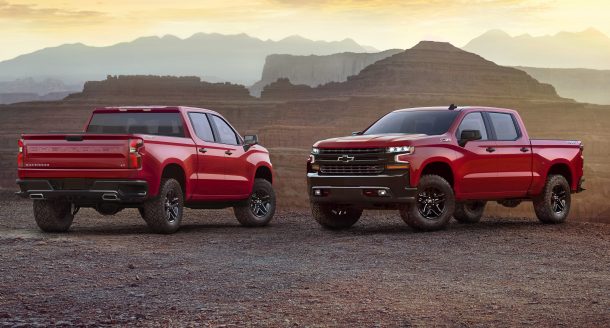As Pickups Become Family Vehicles, GM Vows to Correct Crew Cab Shortage

When thinking of a four-door pickup dating from before the current century, one envisions work crews heading to a construction or logging site. Now, these vehicles ferry mom, dad, Caden, and Brayden to Lowes.
The transformation of the pickup from utilitarian hauler to plush, well-appointed family ferry has done wonders for truck sales in North America, with automakers giving thanks for the high-margin boost to their bottom line. However, keeping up with changing preferences isn’t always easy.
General Motors knows that, in order to keep up with its rivals, it needs to build many more crew cab versions of its next-generation Chevrolet Silverado and GMC Sierra.
Speaking to Automotive News, GM product chief Mark Reuss said production of crew cab full-size pickups has been “constrained,” but there’s a plan afoot to change this.
“We’re solving things like that,” Reuss said, without going into further detail. GM claims crew cab models grew from over 50 percent of its full-size pickup sales in 2013 to over 60 percent today. Sales of Chevrolet full-size pickups rose 1.9 percent last year, with its GMC Sierra sibling dropping 1.7 percent in a segment that grew 5.6 percent.
The next-generation Silverado (which debuts Saturday in Detroit) and Sierra call three factories home. Crew cab light-duty models hail from Silao, Mexico, while regular and double cab pickups come from Fort Wayne, Indiana. Flint, Michigan builds heavy duty variants in both cab configurations, as well as light-duty Silverado crew and regular cabs.
Having spent $3 billion retooling the plants, GM needs to satisfy as many customers as possible with the new models. We’ve already had a glimpse of the 2019 Silverado, seen above, while the next-gen Sierra remains shrouded in mystery.
Judging by a report we brought you in 2016, it seems likely the Flint plant will play a role in the boosted crew cab output. According to a UAW shop chairman, GM decided to send additional Silverado 1500 production to Michigan starting last year, after its Mexican truck plant couldn’t satisfy demand.
[Image: General Motors]

More by Steph Willems
Latest Car Reviews
Read moreLatest Product Reviews
Read moreRecent Comments
- 1sowa Its clearly the "Honda Anyone"
- Oberkanone Nope. Never. Run away. Unreliable money pit.
- Cprescott Good riddance. I hear rent is really cheap in Gary, Indiana.
- Cprescott Apple will eliminate 1 tire and wheel since that is redundant and will make sure the computer system is fruit based and incompatible with anything else.
- Theflyersfan To: Fisker Manhattan Beach EmployeesFrom: The walking god himselfRe: Why your badge didn't workHey guys, you probably noticed some changes this morning like the locks being changed and the lights being out. Don't worry. Bob in Accounting has a huge basement and a pool table so we're going to move on there for our new super awesome headquarters. Get there quickly before the good parking is gone!

































Comments
Join the conversation
Crew cab = G37 sedan Extended cab = G37 coupe Regular cab = 370Z After driving a U-Haul Sierra I dig the whole pickup thing now... though I don't think I'd want one any bigger than that version, and I'd need AWD. RWD trucks have awful traction
This is terrifying! These things are extremely dangerous to regular cars in a collision. Having driven a crew cab F-150 recently, I can think of the only reason why it would be so popular -- cowardly people buying the biggest and heaviest vehicle they can afford. Because they are scared. They want to win in a crash against another vehicle. This is an arms race that can only lead to bigger and heavier monsters clogging up American highways. The F-150 I drove was just amazingly bad at everything, except being incredibly big. No pleasure can be extracted from driving one. The suspension is terrible, the steering is terrible, the cabin is extremely uncomfortable. It is extremely difficult to climb up into. Little kids need assistance because they cannot reach that high. Old people cannot climb in at all. The interior is incredibly wasteful of space with huge seats and huge center console. The bed is not possible to use to carry anything because it is just too high to reach. It cannot be parked without taking up the entire width of a parking space that makes the doors impossible to open without hitting the vehicle parked next to you. It does not fit in a garage. It does not fit in the driveway. It does not fit in the city. The tires cost a fortune to replace. Did I mention it is terrible to drive? Utterly disgusting! I can see people using these for work, although it seems that a reasonably sized van would be more economical and practical. But I cannot see using one as a family vehicle. It fails on all counts at that, except for winning in a two vehicle crash.